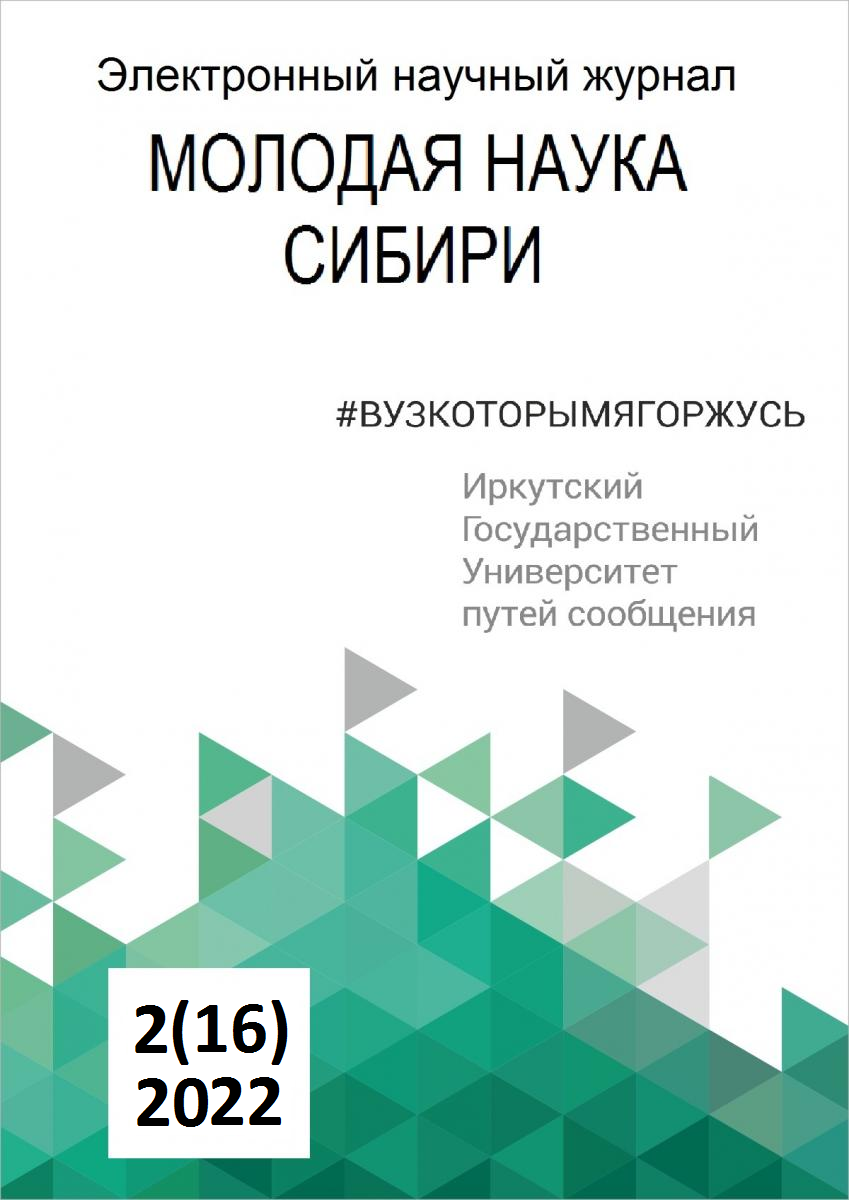AUTOMATED SYSTEM FOR ACCOUNTING AND CONTROL OF FAILURES IN THE OPERATION OF TECHNICAL FACILITIES (KASANT)
Keywords:
system analysis, traffic safety, monitoring of infrastructure facilities and railway rolling stock, fixing the fact of failure of technical means, KASANT systemAbstract
The article discusses an automated system for ensuring the safety of rolling stock traffic, designed for the infrastructure of Russian Railways in the general process of technical operation. An important place in the work is acquired by system analysis, which requires a system that includes monitoring of infrastructure facilities and railway rolling stock as a whole.
This system represents not only the unity of the order of technical systems, but also the investigation of cases of failures of technical means on all roads of Russian Railways, as well as an increase in the reliability and efficiency of collecting information due to the electronic technology of the process. A distinctive feature of the KASANT system from local information developments operating on the railway network was the automatic fixation of the fact of failure of technical means. In order to correctly take into account the fact of failure, the system implements a specialized mechanism for checking incoming data for duplication with the possibility of subsequent merging of user data. The development prospect of this system is the development of a subsystem for determining reliability indicators for the main types of equipment. The task of assessing the reliability of technical means is relevant for the infrastructure of railway transport. The KASANT system implements the tasks of assessing the economic losses from failures, allowing you to determine the direction of investment in the development of the material and technical base of the company. At the same time, the system for assessing the quality of work of types of equipment changes from quantitative indicators. This assessment is more objective and acceptable from an economic point of view.
References
Амелин С.В., Андреев Г.Е. Устройство и эксплуатация пути, 1986. С. 55-59.
Мельниченко О.В., Цыбульский В.С., Чикиркин О.В. Повышение качества электрической энергии в контактной сети с целью снижения отказов электронного и силового оборудования электровоза // Современные технологии. Системный анализ. Моделирование. 2008. №3(19). С.58-66/
Мельниченко О.В. Протокол эксплуатационных тягово-энергетических испытаний электровоза переменного тока ВЛ80Р № 1829 по Договору ИрГУПС с ОАО «РЖД» № 726/493 от 08.06.2010 г.
Ершков О.П. Расчет рельса на действие боковых сил в кривых // Тр. ЦНИИ МПС. Вып. 192. М.: Трансжелдориздат, 1960. С. 5-58
Гребенюк П.Т., Долганов А.Н., Некрасов О.А., Лисицын А.Л., Стромский П.П., Боровиков А.П., Чукова Т.С., Григоренко В.Г., Первушина В.М. Правила тяговых расчетов для поездной работы // М.: Транспорт, 1985. 287 с.
Комиссаров А.Ф. Итоги работы проектно-конструкторского бюро вагонного хозяйства за 2018 г. // Вагоны и вагонное хозяйство. Приложение к журналу «Локомотив», М.: 2019. №1(49). С. 5-6.
Черняк Ю.В, Матвиенко А.С Определение силы тяги локомотива при производстве тягово-энергетических испытаний. Сборник научных трудов. Дон I 3Т №12 2007 С.116-126.
Жуков И.В. Автономное устройство регистрации расширяет возможности испытательных поездов (Вагон тормозоиспытательный) // Вагоны и вагонное хозяйство. Приложение к журналу «Локомотив», М.: 2019. №1(49). С. 40-41.
Доронин И.С. Расчет шейки оси колесной пары на продольную нагрузку // Вестник ВНИИЖТ, 1978. С. 33-34.
Филлипов В. Н., Смольянинов А. В., Козлов И. В., Подлесников Я. Д. Инновационные вагоны и проблемы их взаимодействия с элементами инфраструктуры. Безопасность движения поездов // Труды Семнадцатой научно-практической конференции. - М.: МГУПС (МИИТ), 2016. С 68-73.
Стратегия развития железнодорожного транспорта в РФ до 2030 года // Распоряжение Правительства РФ от 17 июня 2008 г. №877-р.
Мотовилов К. В., Лукашук В. С., Криворудченко В. Ф., Петров А. А.; под ред. Мотовилова К. В. // Технология производства и ремонта вагонов. - М.: Маршрут, 2013.
Романова О.В., Боботкова В.Н. Взаимодействие пути и подвижного состава // Материалы X Международной студенческой научной конференции, Студенческий научный форум URL: https://scienceforum.ru/2018/article/2018005669.
Байбаков А. Н., Гуренко В. М., Патерикин В. И., Юношев С. П., Плотников С. В., Сотников В. В., Чугуй Ю. В. Автоматический контроль геометрических параметров колесных пар во время движения поезда // URL: https://cyberleninka.ru/article/n/lazernyy-diagnosticheskiy-kompleks-dlya-kontrolya-kolesnyh-par-vagonov-na-hodu-poezda.
Hauschild G. Автоматическая диагностика колесных пар с помощью системы ARGUSÄ// Glasers Annalen, 2001, № 12, S. 615-625.
Morgan R. Оценка систем измерения колес // Railway Track & Structures, 2002, № 7, S 13-15.
Венедиктов А. З., Демкин В. Н., Доков Д. С. Измерение параметров колесных пар подвижного состава в движении // ЖДМ, 2003, № 9.
Инструменты и принадлежности осмотрщика-ремонтника вагонов. URL: http://www.xn--80adeukqag.xn--p1ai/2016/01/blog-post_42.html.


